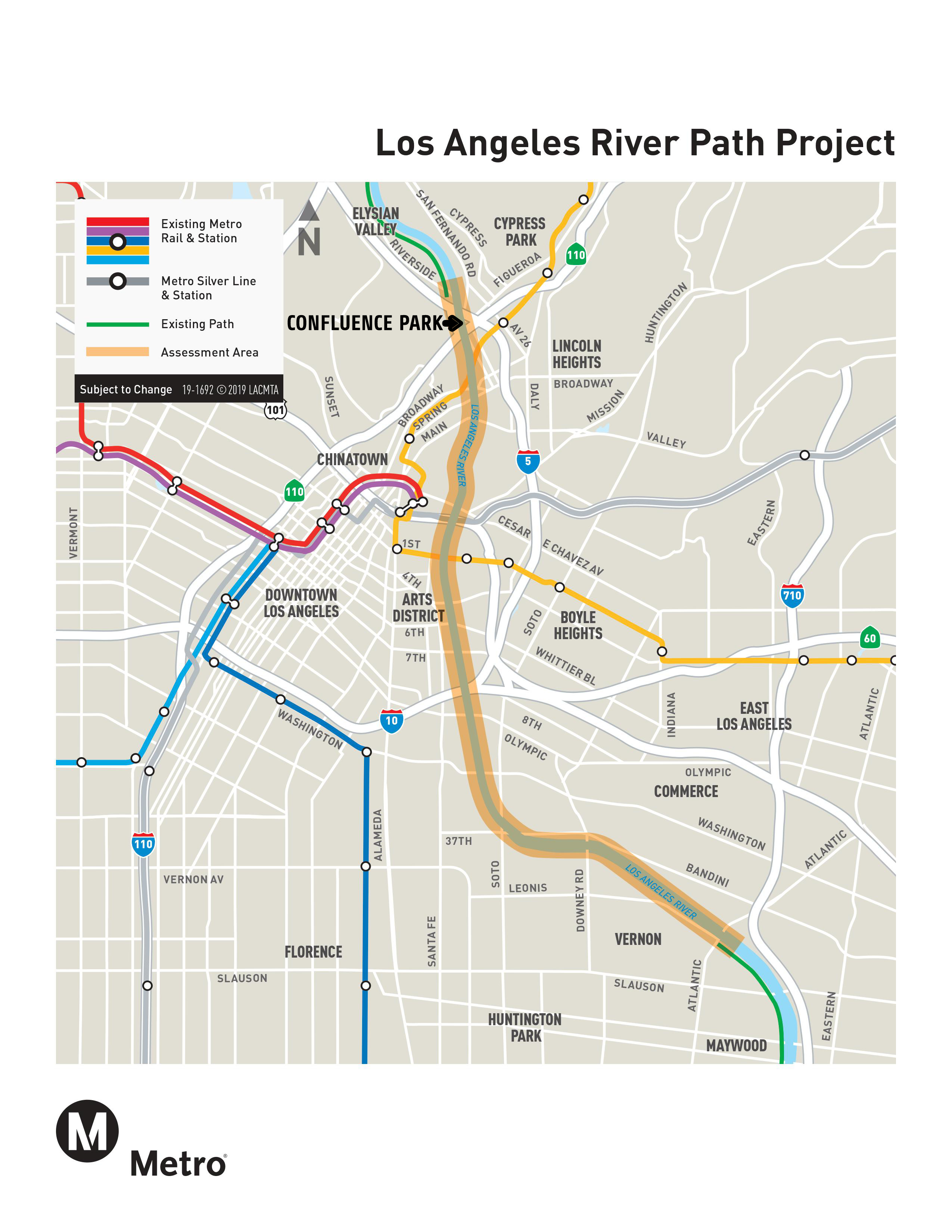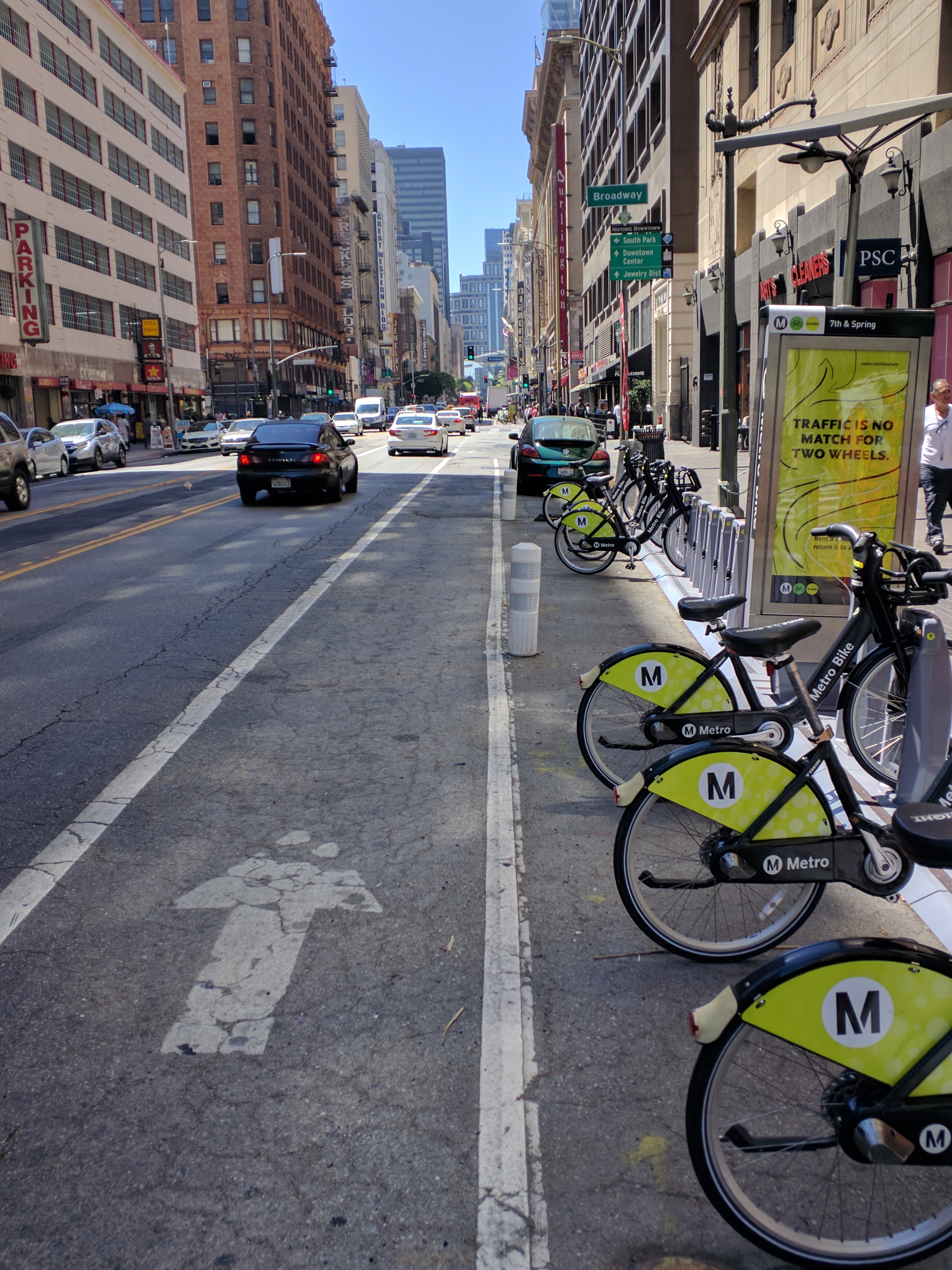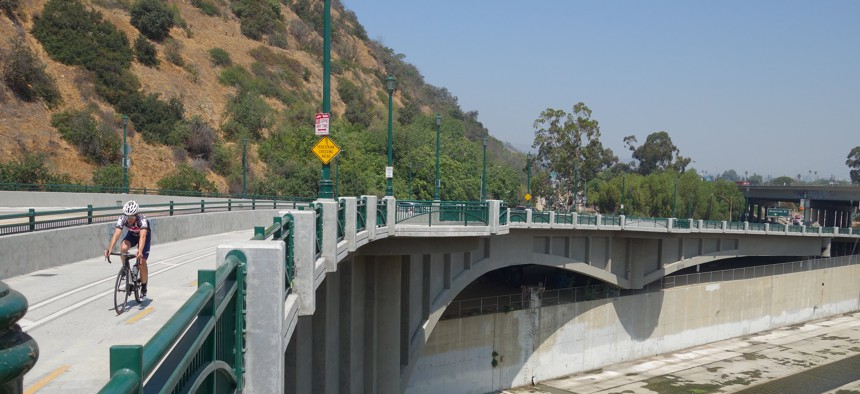Connecting state and local government leaders
The path along the Los Angeles River could connect a large swath of this famously car-centric city. But first the city needs to build out an eight-mile gap—no easy undertaking.
The northern portion of the Los Angeles River Bike Path winds past the Autry Museum of the American West and the Spoke Bicycle Cafe in Frogtown, until it ends abruptly at an attractive landscaped roundabout near Confluence Park, about two miles north of downtown. Enthusiastic cyclists tend to come flying out the exit point here where a new bridge and smooth surface are conducive to speed. But then they need to stop. Faced with a mostly industrial landscape busy with truck traffic, riders have little choice but to turn around and head back to the San Fernando Valley.
Creating a safe path south from this point will require filling a long eight-mile gap in Los Angeles’ bike infrastructure. One that runs a gauntlet of power lines, roads, and riverbed past Dodger Stadium, through downtown and the newly emerging arts district, then onward to connect to its southern counterpart in Vernon, a municipality dominated by vast railyards. And doing so now constitutes one of the more complex infrastructure projects L.A. has taken on in years.
The prize will be a unique asset, the likes of which Los Angeles has not seen before: a continuous walking and cycling path from the far western reaches of San Fernando Valley through downtown and then south to Long Beach, following the curves of the Los Angeles River. Combined with even more ambitious plans to restore the river itself to its natural state, the path will offer hundreds of thousands of people a new entry point to nature. Understandably, the city aims to finish the project in time for the 2028 Olympics.

“This has been a dream for the region for such a long period of time, and fair to say, decades,” says Lauren Cincic, senior director Countywide Planning and Development at LA Metro. Metro is the agency largely tasked with organizing the effort, bringing together stakeholders from private property owners to state and county agencies.
Unlike many cities Los Angeles does not have a central, organizing feature—a Central Park, a Champs-Ellysees. Could the river and bike path project create such an asset? “I don’t think we’ll ever have one, central spine” says Will Wright, director of government and public affairs at AIA Los Angeles. “But the L.A. River does create an intriguing focal point. Returning to human power, and the river, becomes a really good way to connect neighborhoods.” While there are smaller gaps along the bike path currently being completed with small tranches of funding from many sources, building out the eight-mile stretch comes entirely from the historic Measure M, according to Metro’s Cincic. Voters in 2017 chose overwhelmingly to tax themselves an extra half cent in sales tax for the next 20 years to complete a wide array of transit and other transportation projects. Metro has said the river bike path will get $365 million from Measure M.
Daveed Kapoor is a local architect at Utopiad.org who’s lived next to the river for decades, and as a cyclist, actually rides down into the river during the dry months to visit his parents well south of downtown. “On a dry day I can bike right in the channel. But then I have to pop out when the surface gets slimy, so I’m back on the streets for a few blocks, and then on again to the river in Vernon.” Kapoor laughs, remembering the few times he’s wiped out in the wet patches, but instructively, his makeshift ride roughly traces out the gap fill project: he begins his journey not far from where the current river path ends north of downtown. Of course, this route doesn’t work in the winter months, when the river fills up and can become dangerous.
Arroyo seco, or dry stream, characterizes southwest rivers: punctuated as they are by flash floods. And LA is no different. During the catastrophic floods of 1938, when the river burst its banks at Elysian Park, Angelenos finally demanded the river be tamed. The hemmed in river you see today, a massive concrete channel is the result. And now that the river is itself a piece of hard infrastructure, this both organizes but greatly challenges the ambitious gap-filling project.
Both Kapoor and AIA’s Wright identify the leg immediately south of Confluence Park as a pinch point. To extend the path from the current terminus will require threading a path through Glendale Junction where the river, Highway 110, Interstate 5, and existing rail and power lines are all squeezed together; along with a Metro Gold Line yard facility and even a pop-up open air nightclub, The Viaduct. Los Angeles magazine described the music venue, which embraces the nearby passing trains, as “the most interesting new venue in Los Angeles, and technically it doesn’t exist.”
But other cities have found solutions to such pinch points. In Portland, the East Bank Esplanade trail also had to squeeze in between a river, existing bridges, narrow land strips, and yes, Interstate 5. One solution, to get around narrow passages, is to actually add some additional hard infrastructure, and Kapoor has dealt previously with such challenges. “In a related project in Culver City, where the creek wall was vertical...we cantilevered out, in this case to provide parking. So, it’s technically feasible.” Metro’s Lauren Cencic also cited cantilevering—extending a deck-like structure outward horizontally—as one type of solution, pointing out that parts of the route traverse very narrow corridors of land, with the channelized river bank cascading downward on one side, and rail beds to the other. Interestingly, Portland chose to build several cantilevered sections for short distances, and these hang out over downslopes that meet the river. But they’re built up in a way that cyclists aren’t aware the road surface is technically suspended. One solution Portland chose, conversely, wouldn’t work at all in Los Angeles, and that’s floating pontoons. The Willamette River rises and falls, but not like an arroyo seco.

Cycling in Los Angeles has come a long way since Mayor Eric Garcetti, himself an avid rider, came to office. But birthing pains are still evident. Downtown L.A. has blossomed with a bike sharing program, but functional bike lanes have been slow in coming. Many lanes stop after several blocks and most are simply painted. Finally this spring, downtown L.A. opened its first two-way protected route along Spring Street. Alas, it’s short. Moreover, another large project, the giant Sixth Street Viaduct, was initially billed as featuring a protected, rather than painted, bike lane but the city has since vaccilated on that promise, dispiriting the bike community.
Kapoor makes the point that the Los Angeles River Bike path, while currently useable in parts, won’t fully come alive until it’s completed. “That’s why so many people don’t ride in L.A., because there’s always that one point where you, you know, feel like you’re going to die.” Kapoor laughs again at his maudlin joke, but the point stands. This seems to be a truism about cycling in urban areas. Gaps mean you’re always dealing with a “90 percent solution,” says Kapoor. Los Angeles finds itself in a position not unlike other cities, where 20th century road-building cut off populations either from the ability to walk freely and safely, or, from waterfronts. The removal of San Francisco’s Embarcadero highway and now Seattle’s Alaskan Way Viaduct preview the desire to reconnect with water, and the completion of the L.A. River Bike Path will, using an urban planner’s term, activate the river for communities along the way.

So where are we today? The project is very much in its conceptual and design stage, with a lot of attention on public feedback. “Over the past 11 months we’ve really been focusing on community and stakeholder engagement,” says Metro’s Lauren Cencic. “We’ve done nine public meetings, dozens of pop-up community events, stakeholder briefings and public surveys. We want alot of feedback. And now we have three to four thousand points of public input on the project.”
According to Cencic, the feedback has been quite helpful, and the public has focused on “where the access points will be.” This is a positive sign. Communities (and commuters) are going to have a major new resource to utilize, so most want to know how close they’ll be to the safety of the path. One effect of new bike routes seen elsewhere is the activation of adjacent resources. After Detroit’s Dequindre Cut was completed, slowly but surely, other businesses and institutions saw the attractiveness of the corridor and started moving towards it.
Los Angeles likely has myriad adjacent resources that could come alive once the bike path starts to complete. Already, in other parts of the river, pedestrian (and equestrian) bridges are being erected. AIA Los Angeles’ Will Wright cites the Corralitas Red Car Trail path as a kind of spur that might come into play as a network effect begins to take hold. On the east side of the L.A. River, the trail runs north from the Glendale freeway to a point near Interstate 5 that’s just a thousand feet or so from the existing bike path as it winds down from Griffith Park towards its northern terminus. Once the railbed of the Red Car trolley system, this would grant residents of the Silver Lake neighborhood an access point. And, would act as a resurrection of a lovely bit of LA history.
Editor's note: This story was edited after publication to fix a typo in the spelling of Autry Museum of the American West.
Gregor Macdonald is a journalist who regularly covers cities, climate and energy. He is based in Portland, Oregon.

NEXT STORY: Massachusetts taps Verizon for public-safety wireless services



